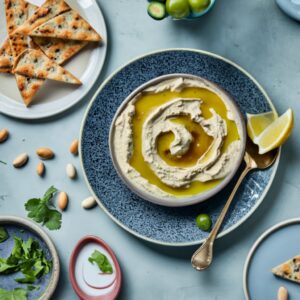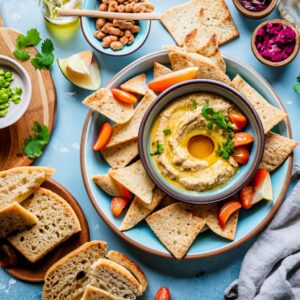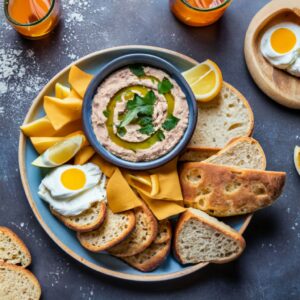
Unleash the culinary artist within by mastering the craft of homemade hummus. This Middle Eastern classic, born from chickpeas, tahini, and a burst of flavors, promises a velvety delight. Whether you’re a kitchen enthusiast or a novice, creating your hummus invites a taste journey that transcends cultural borders. Dive into simplicity, savor the creamy outcome, and elevate your snacking experience with this versatile and homemade favorite.
What Is Hummus:

Hummus: A Culinary Delight
Hummus is a versatile and delectable Middle Eastern dip that has gained widespread popularity across the globe. This savory spread is crafted from a simple yet harmonious combination of chickpeas (garbanzo beans), tahini (sesame seed paste), garlic, lemon juice, and olive oil. The ingredients are blended to perfection, resulting in a smooth and creamy texture with a rich, nutty flavor profile.
Key Ingredients:
- Chickpeas (Garbanzo Beans): The heart of hummus, chickpeas contribute a mild and nutty taste while providing a substantial, creamy texture.
- Tahini: A paste made from ground sesame seeds, tahini adds a distinctive nuttiness and depth to the flavor, enhancing the overall creaminess of the dip.
- Garlic: Adding a pungent and aromatic element, garlic infuses hummus with a robust and savory character.
- Lemon Juice: Fresh lemon juice brightens the flavors, imparting a subtle citrusy zing that balances the richness of the tahini.
- Olive Oil: High-quality olive oil not only contributes to the smooth consistency but also enhances the overall taste with its fruity and slightly peppery notes.
Versatile and Adaptable: One of hummus’s defining characteristics is its versatility. While the classic version remains a perennial favorite, creative variations abound. Spinach, roasted red pepper, sun-dried tomato, and even spicy variations provide an array of options to suit different palates.
Homemade Hummus Recipe:
Ingredients:
- 1 can (15 oz) chickpeas (garbanzo beans), drained and rinsed
- 1/3 cup tahini
- 1/4 cup extra-virgin olive oil (plus extra for drizzling)
- 3 tablespoons fresh lemon juice (about 1 large lemon)
- 2 cloves garlic, peeled
- 1/2 teaspoon ground cumin
- 1/4 teaspoon paprika (plus extra for garnish)
- Salt, to taste
- 2 to 3 tablespoons ice water (optional, for desired consistency)
- Fresh parsley, chopped (for garnish, optional)
Instructions:
- Prepare Chickpeas:
- Drain and rinse the chickpeas thoroughly under cold water. If you have extra time, you can peel the skins off for an even smoother hummus.
- Blend Ingredients:
- In a food processor, combine the chickpeas, tahini, olive oil, lemon juice, garlic, cumin, paprika, and a pinch of salt.
- Blend Until Smooth:
- Process the ingredients until smooth and creamy. If the mixture seems too thick, you can add ice water gradually until you reach your desired consistency.
- Taste and Adjust:
- Taste the hummus and adjust the seasoning by adding more salt or lemon juice if needed.
- Serve:
- Scoop the hummus into a serving bowl. Create a well in the center with the back of a spoon.
- Garnish:
- Drizzle olive oil over the top, sprinkle with a pinch of paprika, and garnish with fresh chopped parsley if desired.
- Serve and Enjoy:
- Serve the hummus with pita bread, crackers, or an assortment of fresh vegetables. It’s also great as a spread or dip for sandwiches, wraps, or as a flavorful accompaniment to various dishes.
Note:
- You can customize your hummus by adding ingredients like roasted red peppers, sun-dried tomatoes, or fresh herbs during the blending process for different flavor variations.
- Adjust the consistency by adding more ice water if you prefer a lighter and smoother hummus.
With this simple homemade hummus recipe, you can enjoy a delicious and creamy dip that’s perfect for various occasions. Experiment with flavors and find your favorite variations to make it uniquely yours!
what does hummus taste like

Hummus has a rich and savory flavor profile with a delightful combination of earthy, nutty, and slightly tangy notes. The primary ingredients contribute to its taste:
- Chickpeas (Garbanzo Beans): Provide a mild, nutty flavor, adding a subtle earthiness to the hummus.
- Tahini (Sesame Seed Paste): Imparts a creamy texture and a distinct nuttiness to the overall taste.
- Garlic: Adds a pungent and aromatic kick, enhancing the savory character of the dip.
- Lemon Juice: Offers a bright, citrusy zing that balances the richness of the tahini and complements the overall composition.
- Olive Oil: Enhances the smoothness and contributes fruity and slightly peppery undertones.
Additionally, the optional use of spices like cumin and paprika may add warm and smoky notes to the flavor. The overall result is a creamy, well-balanced dip that pairs well with various accompaniments, making it a versatile and beloved dish.
more flavor ideas
Table of creative flavor ideas to enhance your homemade hummus:
| Flavor Variation | Ingredients/Additions |
|---|---|
| Roasted Red Pepper Hummus | Roasted red peppers |
| Sun-Dried Tomato and Basil Hummus | Sun-dried tomatoes, fresh basil |
| Spicy Jalapeño Hummus | Jalapeños |
| Cilantro-Lime Hummus | Cilantro, lime juice |
| Pesto Hummus | Pesto (basil, garlic, pine nuts, Parmesan) |
| Smoky Chipotle Hummus | Chipotle peppers in adobo sauce |
| Avocado Lime Hummus | Ripe avocado, lime juice |
| Curry Hummus | Curry powder or spice blend |
| Buffalo Hummus | Buffalo sauce or hot sauce |
| Greek Olive Hummus | Kalamata olives, oregano, olive oil |
| Sundried Tomato and Feta Hummus | Sundried tomatoes, crumbled feta, basil |
| Honey Sriracha Hummus | Honey, Sriracha sauce |
Feel free to experiment with these flavor ideas and adjust the quantities based on your taste preferences. Customizing your hummus with these variations adds a delightful twist to this classic dip!
what to eat with hummus

Pita Bread or Pita Chips:
- Classic and popular, pita bread or pita chips are perfect for scooping up hummus. Cut the pita into triangles for easy dipping.
Vegetable Sticks:
- Enjoy hummus with an assortment of fresh vegetable sticks such as carrots, cucumber, bell peppers, and cherry tomatoes for a healthy and crunchy snack.
Crackers:
- Choose your favorite crackers, whether they are whole wheat, multigrain, or gluten-free, to dip into the creamy hummus.
Breadsticks:
- Crispy breadsticks provide a satisfying crunch when paired with hummus.
Tortilla Chips:
- Try dipping tortilla chips, nachos, or even vegetable tortilla chips into hummus for a tasty combination.
Flatbread:
- Warm flatbreads, naan, or any type of flatbread make an excellent companion for hummus.
Rice Cakes:
- Enjoy the light and airy texture of rice cakes with a generous spread of hummus.
Falafel:
- Create a Middle Eastern feast by serving hummus alongside freshly made or store-bought falafel.
Cheese and Hummus Plate:
- Pair hummus with a selection of cheeses, olives, and pickles for a delightful appetizer or light meal.
Veggie Wraps: – Spread hummus on a tortilla and fill it with a medley of fresh vegetables for a quick and nutritious wrap.
Grilled Chicken or Shrimp: – Use hummus as a flavorful dip or sauce for grilled chicken skewers or shrimp.
Salads: – Drizzle hummus as a dressing on salads or use it as a tasty topping for grain bowls and salads.
Egg Sandwiches: – Add a dollop of hummus to your favorite egg sandwich for an extra layer of creaminess and flavor.
Stuffed Bell Peppers: – Fill hollowed-out bell peppers with hummus for a simple and tasty appetizer.
Hummus and Veggie Pizza: – Spread hummus on pizza crust as a base, then top with a variety of roasted vegetables for a unique twist on pizza.
how long does hummus last

Hummus Storage and Shelf Life:
Storage:
- Refrigeration: Store homemade or store-bought hummus in an airtight container in the refrigerator.
- Sealing: Ensure the container is sealed tightly to prevent air exposure, which can lead to drying.
Shelf Life:
- Store-Bought Hummus: Follow the expiration date on the packaging. Once opened, consume within the recommended time frame.
- Homemade Hummus: Typically, homemade hummus can last in the refrigerator for about 3-7 days, depending on the freshness of the ingredients used.
Tips for Extended Shelf Life:
- Surface Covering: When storing homemade hummus, place a layer of plastic wrap directly on the surface before sealing the container. This helps prevent the formation of a dry layer on top.
- Stir Before Use: If you notice any separation or moisture on the surface of stored hummus, give it a good stir before serving.
- Avoid Double Dipping: Use clean utensils to avoid introducing contaminants into the hummus, which can reduce its shelf life.
- Freezing: Hummus can be frozen for longer storage. Place it in a freezer-safe container, leaving some room for expansion. Thaw in the refrigerator before using.
- Add Lemon Juice: A little extra lemon juice can help preserve the freshness of hummus. Adjust the acidity to your taste preference.
Packaging Tips:
- Airtight Containers: Use airtight containers to minimize exposure to air and maintain freshness.
- Dark-Colored Containers: If possible, choose containers that are opaque or dark in color to protect the hummus from light, which can degrade its quality.
- Single-Portion Containers: Consider dividing large batches into smaller, single-portion containers. This reduces the frequency of opening and closing the main container, preserving the rest.
- Vacuum-Sealed Bags: If freezing hummus, consider using vacuum-sealed bags to minimize air contact and prevent freezer burn.
General Tips:
- Inspect Before Consumption: Always check for any signs of spoilage, such as an off odor, unusual color changes, or mold. Discard if there are any doubts about its safety.
- Room Temperature Storage: Avoid leaving hummus at room temperature for extended periods, especially in warm conditions, as this can hasten spoilage.
nutrition table
Creating a precise nutrition table would depend on the specific ingredients and quantities used in your homemade hummus. However, here’s a general approximate nutrition table per serving (about 2 tablespoons) for a classic hummus recipe:
Nutrition Information for Homemade Hummus (Per Serving – Approximately 2 tablespoons)
| Nutrient | Amount |
|---|---|
| Calories | ~50 calories |
| Total Fat | ~3.5 grams |
| Saturated Fat | ~0.5 grams |
| Cholesterol | 0 milligrams |
| Sodium | ~100 milligrams |
| Total Carbohydrates | ~4 grams |
| Dietary Fiber | ~1.5 grams |
| Sugars | ~0.5 grams |
| Protein | ~1.5 grams |
Note: These values are approximate and may vary based on specific ingredients and their quantities. If your hummus includes additional ingredients such as olive oil, tahini, or other flavorings, the nutritional content may change.
For more accurate information, you can use a nutritional calculator or refer to the nutritional labels on specific ingredients you use in your homemade hummus.
what to eat with hummus for weight loss

Vegetable Sticks: Carrot, cucumber, celery, and bell pepper sticks are low in calories and high in fiber, making them excellent choices for dipping into hummus.
Cherry Tomatoes: These little tomatoes are not only flavorful but also low in calories. They add a burst of sweetness and acidity to balance the creaminess of hummus.
Radishes: Radishes provide a satisfying crunch and are very low in calories. They add a peppery flavor that pairs well with hummus.
Broccoli and Cauliflower Florets: These cruciferous vegetables are rich in fiber and vitamins, offering a nutritious option for dipping.
Whole Grain Crackers: Opt for whole grain or whole wheat crackers with hummus. They provide complex carbohydrates and fiber for sustained energy.
Rice Cakes: Choose plain rice cakes as a low-calorie and gluten-free option to pair with hummus.
Endive Leaves: Use endive leaves as a vessel for hummus. They have a slightly bitter taste and add a unique crunch.
Jicama Slices: Jicama is a crisp and slightly sweet root vegetable that’s low in calories and makes a great hummus companion.
Zucchini Slices: Thinly sliced raw zucchini is a refreshing and low-calorie option for dipping.
Celery Sticks: – Celery is known for being very low in calories and adds a satisfying crunch to your hummus snack.
Cauliflower Rice or Florets: – Replace traditional grains with cauliflower rice or small florets for a lighter option.
Hard-Boiled Eggs: – Slice hard-boiled eggs and top them with a small amount of hummus for a protein-rich and satisfying snack.
Bell Pepper Halves: – Instead of using crackers, use bell pepper halves to scoop up hummus. They’re colorful and packed with vitamins.
Lean Protein Options: – Pair hummus with lean protein sources such as grilled chicken, turkey slices, or baked fish for a balanced and filling meal.
Fruit Slices in Moderation: – While fruits contain natural sugars, small portions of apple or pear slices can add a touch of sweetness to your hummus snack.
FAQ’S
Is hummus good for you? Hummus is considered a nutritious food. It’s a good source of plant-based protein, fiber, healthy fats, and various vitamins and minerals. Additionally, it may have potential health benefits, such as supporting heart health and aiding digestion.
What is hummus made of? Hummus is typically made from cooked and mashed chickpeas (garbanzo beans), blended with tahini (ground sesame seeds), olive oil, lemon juice, garlic, and salt. Variations may include additional ingredients like cumin or paprika.
What is hummus traditionally eaten with? Traditionally, hummus is eaten as a dip with pita bread. It also pairs well with various foods such as vegetable sticks, crackers, falafel, and as a spread in sandwiches or wraps.
How do you eat hummus? Hummus can be enjoyed in multiple ways: as a dip for veggies or chips, spread on bread or crackers, as a topping for salads, or as a side with dishes like falafel or grilled meats.
Are there any negatives to eating hummus? While hummus is generally healthy, some store-bought varieties may contain added sugars or preservatives. Also, individuals with allergies to ingredients like sesame or garlic should be cautious.
Is it OK to eat a whole tub of hummus? While hummus is nutritious, moderation is key due to its caloric content. Consuming a whole tub may lead to excessive calorie intake. It’s best enjoyed as part of a balanced diet.
Is hummus a fat or carb? Hummus contains both fats and carbohydrates. The primary sources are healthy fats from olive oil and carbohydrates from chickpeas.
Is hummus a fat or carb or protein? Hummus is a balanced food, containing healthy fats from olive oil, carbohydrates from chickpeas, and protein from both chickpeas and tahini.
How long does hummus last in the fridge? Homemade hummus typically lasts about 3-5 days in the refrigerator. Store-bought hummus may have a longer shelf life; follow the expiration date on the packaging.
What is the best flavor of hummus? The best flavor of hummus is subjective and varies among individuals. Popular flavors include classic, roasted red pepper, garlic, or olive. Personal preference plays a significant role.
Is hummus a full meal? While hummus is nutrient-dense, it’s not a complete meal on its own. Pair it with other foods like whole grains, vegetables, or protein sources for a well-rounded meal.
What is best to dip in hummus? Hummus pairs well with vegetable sticks (carrots, cucumbers), pita bread or chips, whole grain crackers, and even falafel.
Why can’t you eat hummus after 2 days? Homemade hummus may start to spoil after 2 days due to the presence of fresh ingredients. Refrigerate promptly and consume within the recommended time frame.
What is healthier, hummus or peanut butter? Both hummus and peanut butter are nutritious, but their nutritional profiles differ. Hummus is lower in saturated fats, while peanut butter provides more protein. The choice depends on individual dietary preferences and needs.
What meat goes well with hummus? Grilled chicken, lamb, or beef pairs well with hummus. The creaminess of hummus complements the flavors of these meats.
Why do I get sick after eating hummus? Sickness after eating hummus could result from various factors, including food allergies, contamination, or individual sensitivity to ingredients. Consult a healthcare professional if symptoms persist.
Can I freeze hummus? Yes, hummus can be frozen for future use. It may have a slightly altered texture upon thawing, so stir well before consuming.
Can you eat hummus 10 days out of date? It’s not advisable to eat hummus 10 days past its expiration date. Follow the recommended storage guidelines to ensure freshness and safety.
Can I eat hummus that was left out overnight? It’s safer to discard hummus left out overnight, as bacteria can multiply rapidly at room temperature, leading to foodborne illness.
Does unopened hummus really expire? Unopened store-bought hummus has a longer shelf life and typically stays fresh until the expiration date on the packaging. Check for signs of spoilage before consuming.
